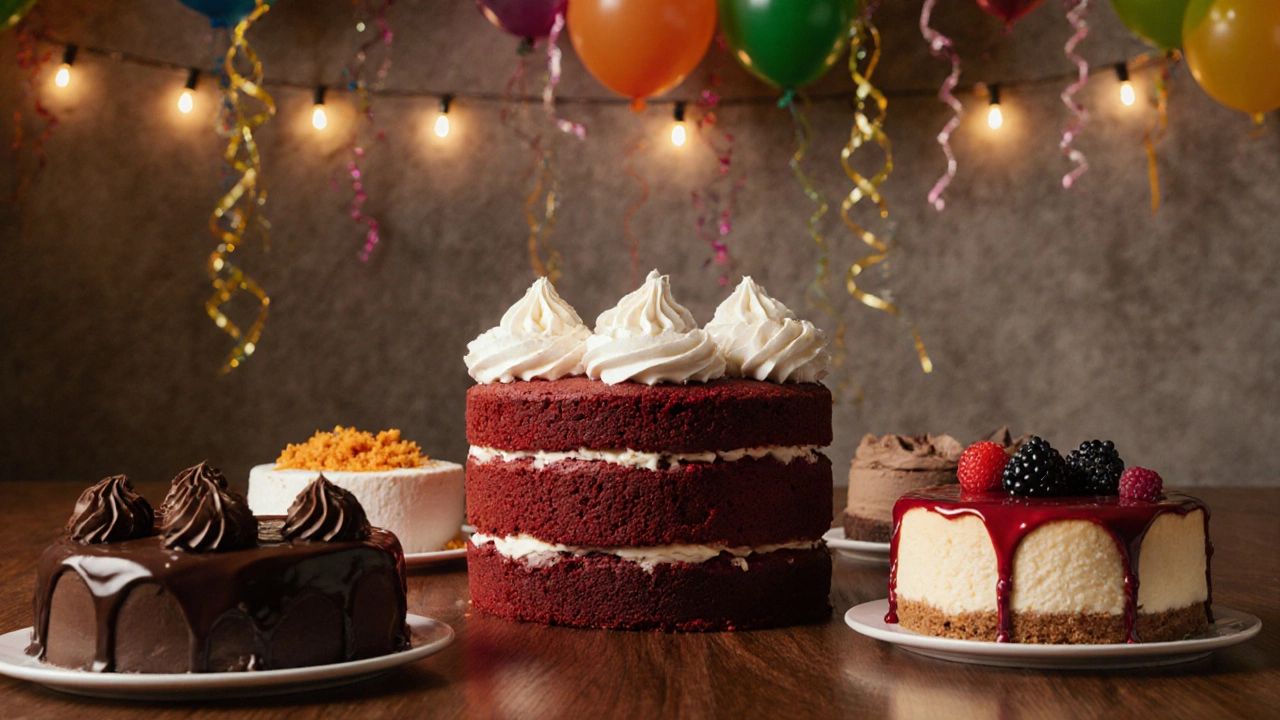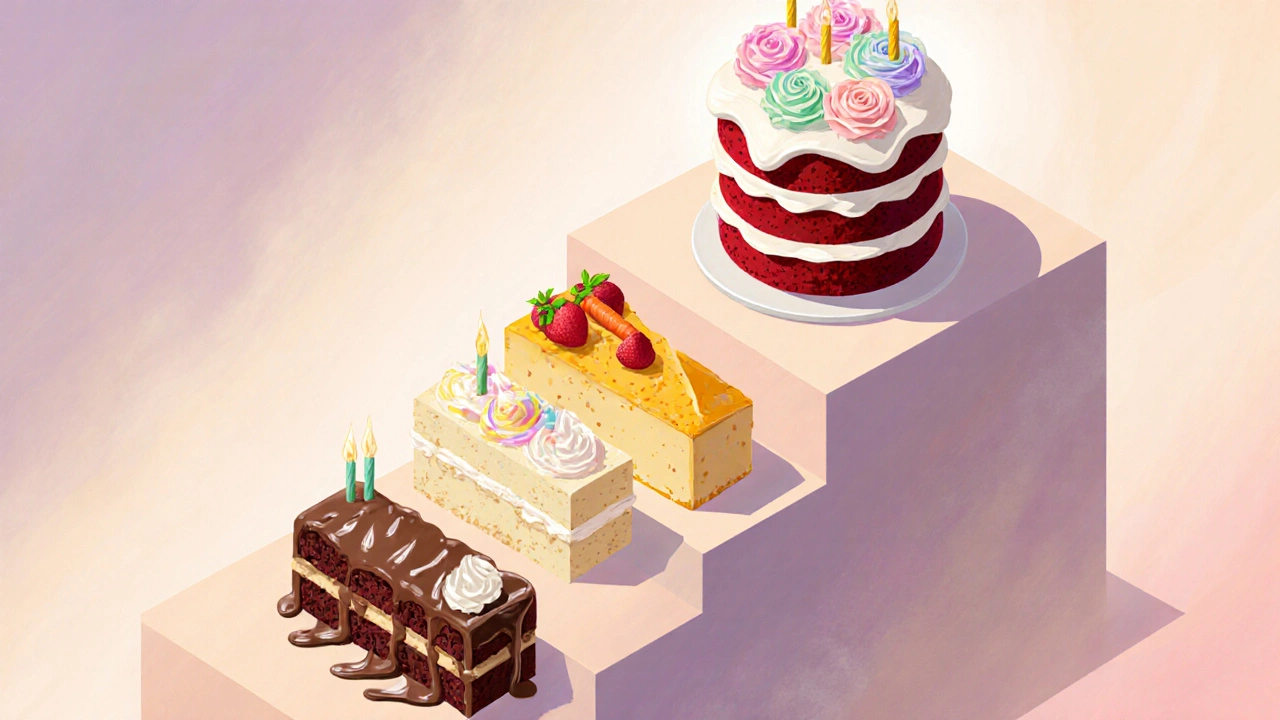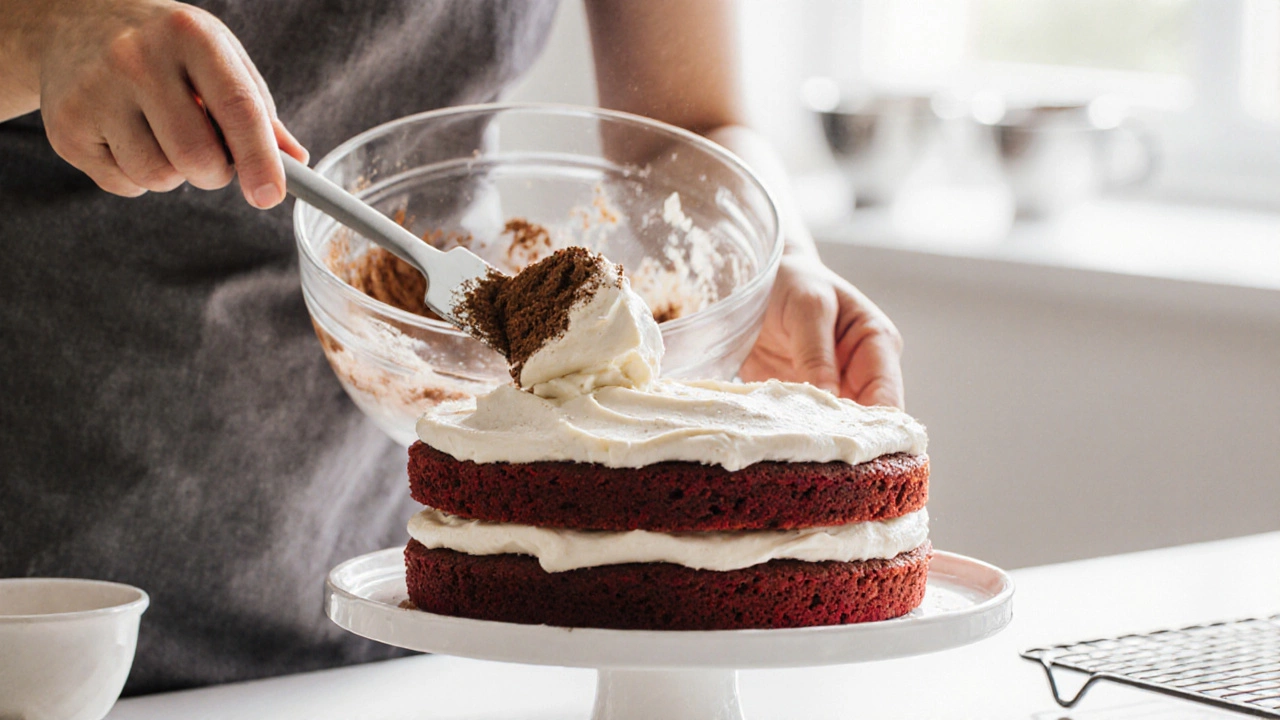
Birthday Cake Cost Calculator
Calculate Your Birthday Cake Budget
Based on 2024 National Confectioners Association data, Red Velvet cake is America's #1 birthday cake at 28% popularity. Using the calculator below, estimate your party costs.
Estimated Cost
$0.00
Why Red Velvet? According to the article, Red Velvet holds 28% of birthday cake orders nationwide with an average cost of $2.50 per serving. Its popularity is driven by social media appeal and the perfect balance of sweet and tangy flavors.
Ever wondered which cake dominates birthday parties across the United States? Surveys, Google trends, and bakery sales all point to a clear front‑runner, and the answer might be different from what you expect. Below we break down the data, the history, and the practical details so you can finally answer the question: America's number one cake.
What qualifies as "America's number one cake"?
Before naming the victor, it helps to define the playing field. For this article the term American birthday cake refers to the most frequently ordered or homemade cake for birthday celebrations across the 50 states. We focus on three data sources:
- Annual consumer surveys from the National Confectioners Association.
- Search volume analysis via Google Trends (2022‑2024).
- Sales reports from major bakery chains such as Food Network and Allrecipes.
By triangulating these sources we get a reliable picture of national preferences.
The data: Top five cakes by popularity
| Rank | Cake | Typical Frosting | Flavor Profile | Average Cost per Serving (USD) |
|---|---|---|---|---|
| 1 | Red Velvet Cake | Cream cheese buttercream | Rich cocoa with a slight tang | $2.50 |
| 2 | Chocolate Layer Cake | Chocolate ganache or chocolate buttercream | Deep chocolate, moist crumb | $2.30 |
| 3 | Classic Vanilla Birthday Cake | Vanilla buttercream or whipped cream | Light, buttery, sweet | $2.10 |
| 4 | Carrot Cake | Cream cheese frosting | Spiced, nutty, moist | $2.40 |
| 5 | Cheesecake | Plain or fruit‑topped | Creamy, slightly tangy | $3.00 |
Red Velvet leads the pack with a 28% share of birthday cake orders, according to the 2024 National Confectioners Association survey. Chocolate follows at 22%, and vanilla holds steady at 18%.
Why Red Velvet outruns the competition
Red Velvet didn’t always enjoy the top spot. In the 1990s, classic vanilla dominated. A few cultural shifts pushed Red Velvet forward:
- Social media exposure: Pinterest boards featuring festive Red Velvet designs exploded after 2015, making the cake a visual staple for celebrations.
- Regional migration: The cake’s Southern roots spread northward as people relocated, expanding its market.
- Flavor balance: The subtle cocoa taste plus the tangy cream cheese frosting hits a sweet‑savory sweet spot that appeals to a broad palate.
These factors combine into what bakery consultants call the "visibility‑taste loop"-when a cake looks good online, more people order it, leading to more exposure, and so on.

How the top cakes differ in preparation and decoration
Choosing the right cake for a birthday isn’t just about flavor; it’s also about logistics. Below is a quick cheat‑sheet for home bakers.
- Red Velvet: Use cocoa powder, buttermilk, and a touch of vinegar for that characteristic crumb. Finish with a generous layer of cream cheese buttercream; it freezes well for advance preparation.
- Chocolate Layer: Opt for an “all‑batter” method-mix dry and wet ingredients separately, then combine. A ganache topping sets a glossy finish that looks professional.
- Classic Vanilla: The simplest recipe-cream butter, sugar, eggs, vanilla extract, and flour. Whipped cream frosting keeps it light for summer birthdays.
- Carrot: Grated carrots, crushed pineapple, and walnuts add moisture. Cream cheese frosting balances the spice.
- Cheesecake: No layers-just a single dense base. Top with fresh berries or a drizzle of caramel; it’s a crowd‑pleaser for more sophisticated palettes.
Each cake also pairs with different decorating styles. Red Velvet shines with bold, high‑contrast lettering; vanilla works best with pastel buttercream roses; chocolate benefits from metallic drips; carrot pairs nicely with rustic, earthy accents; cheesecake is often presented plain or with a simple fruit garnish.
Regional quirks: Does geography matter?
While Red Velvet holds the national title, certain regions prefer local favorites. In the Pacific Northwest, coffee‑infused chocolate cakes rank high, while the Midwest still orders a lot of sheet‑style vanilla with simple frosting. The South, unsurprisingly, shows a higher affinity for carrot cake and pecan‑topped variations.
These trends appear in the Google Trends heat map, where search interest for "red velvet birthday cake" spikes in Texas, Georgia, and New York, but dips slightly in Idaho and Montana where "carrot birthday cake" retains more interest.
What the numbers mean for home bakers and professional shops
If you’re a home baker looking to impress friends, the safest bet is a Red Velvet cake-its visual impact scores high on Instagram, and the flavor pleases most guests. For professional bakeries, the data suggests allocating about 30% of birthday‑cake orders to Red Velvet, 22% to chocolate, and the rest split among vanilla, carrot, and cheesecake.
Pricing strategy matters too. Red Velvet’s average cost per serving ($2.50) sits between chocolate ($2.30) and cheesecake ($3.00). Offering a small premium for the trendy frosting can boost margins without scaring price‑sensitive customers.

Tips for making America’s favorite cake at home
- Prep ahead: Bake the layers 24hours before the party and store them wrapped in the fridge. This improves flavor development.
- Use quality cocoa: Even though Red Velvet has only a hint of chocolate, a high‑quality cocoa powder makes the crumb richer.
- Room‑temperature ingredients: Butter, eggs, and buttermilk should be softened to avoid a dense texture.
- Don’t over‑mix: Once the dry ingredients are added, mix just until combined. Over‑mixing creates a tough crumb.
- Frosting consistency: Cream cheese buttercream should be beaten for at least 3minutes on medium speed to achieve a smooth finish.
Follow these steps, and you’ll serve a cake that not only looks like the champion but also tastes like it.
Mini‑FAQ
Which cake is officially the most popular birthday cake in the U.S.?
Red Velvet cake holds the top spot, capturing roughly 28% of birthday‑cake orders nationwide according to the 2024 National Confectioners Association survey.
Why does Red Velvet outrank classic vanilla?
Its distinctive color, the creamy tang of cream‑cheese frosting, and massive social‑media exposure have made it a visual and taste favorite for modern celebrations.
Can I substitute the frosting and still count as the "number one" cake?
The frosting is a key part of the Red Velvet identity. Switching to plain buttercream may lower the perceived authenticity, but the cake’s flavor will still be recognizable.
What are the biggest regional variations?
The South favors carrot and pecan‑topped cakes, the Northwest leans toward coffee‑infused chocolate, while the Midwest sticks with classic vanilla sheet cakes.
Is Red Velvet a healthy choice?
Like most birthday cakes, it’s a treat. One slice (≈100g) provides around 350calories, 15g of fat, and 45g of carbs. Moderation is key.
Next steps for bakers
Now that you know the champion, decide how you want to use it:
- For a family gathering, bake a single‑layer Red Velvet and frost it with cream cheese buttercream.
- If you run a bakery, add a "Red Velvet Birthday Special" to your menu, pricing it $2.50 per serving as the market benchmark.
- Want to experiment? Try a hybrid-red‑velvet infused with espresso for that Northwest twist.
Whatever path you choose, you’ll be serving the cake that most Americans actually order for birthdays.